Curated ways to stay up to date with technology - Part 2, Curated List
Keeping up with Product Managers and Techies! There are probably 100,001 information sources out there; here is a curated list.
I’d primarily started a post to share my information sources as a curated list but ended up adding more of “how” and “why”, which you can read in Part 1 - Framework.
In Part 2 here, I plan to show a curated list of recommended information sources. I’ll explain the reasoning for recommending sources. I’ll also score each information source on the KPIs we discussed in the previous post and visualize the scores. This post turned out to be really long for an email, so I’ve split a list of rejects or an Anti-Stack into Part 3.
A Curated Stack
My newsletter and podcast stack is divided into
news,
deep-dives into product management or product design,
and learnings from startups.
I find it valuable to combine entrepreneurship and product management sources of information since they help me hear about problem-solving, understanding customer needs, and performing with autonomy and responsibility. I can further divide my stack into collated and individual varients of information.
A) Functional Skills
Marty Cagan - SVPG Newsletter: By the author of Inspired. Each newsletter contains a list of upcoming workshops, a link to an article, and other information. I read the article and ignore the rest of the newsletter. Usually, the articles are derivations of Inspired or parts of his new book, Empowered, so helps reinforce the information.
Adam Silver - Good Design: Newsletter shares 1 topic at a time about good, bad, or confusing UI design. I like to learn about design in bite-sized pieces via this newsletter.
Intercom on Product: Podcast by Intercom to expand further on their ideas for improving as a product manager or improving an organization.
B) Analysis or opinions on news
Ben Thomson’s Stratechery (Free version): In-depth analysis of strategy from big tech. I am on the free version, following my principle of not wanting to spend too much. I get one of the five posts each week, which works well for me. This way I’m able to balance in-depth sources being less frequent.
Benedict Evans (Free version): He shares a few summarized analysis of his own and links to other curated analyses from the web. I like his perspectives and there are so many gems in the links.
The Hustle (Weekend version): Hustle shares opinions and analyses on a few chosen news articles, usually US-centric. They also have long-form news on Sundays and a few other premium offerings such as Trends premium newsletter, a convention called Hustle-con, etc. I recently decided to ignore all of their weekday emails in favor of reading the weekend long-form article because the weekday emails contain a lot of long ads and there is a good amount of overlap in the news vs summarized sources even though the opinions added on top of news are valuable.
My First Million: Podcast run by the co-founder of The Hustle, Sam Parr, and Shaan Puri, they share their takes on business or entrepreneurship news about creating successful businesses or capturing value. It is not very efficient since they stumble through a lot of topics, have some amount of chit-chat, often forget names of websites or businesspersons, and lastly, keep bringing up the same topics just because they forgot they’ve covered it. Their ideation sessions still seem helpful to think in new ways of problems. Also, it is beneficial to get some information that is just for The Hustle - Trends premium subscribers.
C) Collated functional skills
Department of Product - I like their thorough take on the latest developments. Often they have news that I don't hear from other sources. They are efficient in communicating their information, have mutually exclusive information or analysis, and help me improve my functional skills.
Lenny Rachitsky (Free): Love Lenny’s breadth-first approach for in-depth topics and collection of insights from successful companies. This is something I might consider paying for since each update has a lot of insights to help learn from industry leaders, but it still is a lot of content so not sure if it would be worth the time spent. I am on the free version which comes once a month.
Inside Intercom: Intercom shares some insights into building great product teams and good culture in the organization, a few topics at a time.
D) Collated news
Product Hunt Weekly: Collection of updates from Product Hunt, usually curated as per a theme each time. I like to hear the PH community's latest obsessions as they are often pretty ahead of the status quo (think innovators or early adopters).
Tech Crunch Week in Review: I moved from daily to weekly because the daily wasn't great to read through email as most of the snippets were incomplete sentences necessitating clickthrough to the articles. The week in review is complete in itself, which makes it efficient.
Tech Crunch Startups Weekly: Getting to know what kind of startups are growing, where, and why is helpful anecdotal information. It also has a lot of VC news and funding rounds, which isn’t useful in this cadence.
Quartz Daily Brief: Daily summarized news from around the world. Summarized well in the sense that it doesn’t need me to click on links to understand the headline. It has its political leanings, but it is hard to get a neutral news source, so I’m ok with it.
If I were to visualize some of these on the depth/breadth and frequency continuum, this is how it would look like:
However, I realized there were a few outliers in my selection, so I couldn’t fit them all in the above graph. The below is an exhaustive spread of the sources on the depth vs breadth axis:
Comparing the depth of info and efficiency together, we see a trend towards efficient and in-depth sources and that broad sources chosen are efficient.
Product Hunt weekly seems like an outlier, and If I switch from listening to the entire email to reading the first part of PH emails, the relevant efficiency would improve. Inside Intercom and WSJ Future of Everything are infrequent, which helps maintain high efficiency.
An Anti-Stack - What’s in Part 3
I’ve moved a list of rejects, or a sample Anti-Stack to Part 3. The intention of that list is to share one perspective on what didn’t work in a sample set of sources, to help illustrate how the framework we discussed in part 1 can help you build your stack and prune the rest.
Visualizing the Sources on the KPIs
In the previous post, we’d talked about a few axes to measure the value of a source of information. Here I wanted to visualize comparison of how the Stack and Anti-Stack would look like. For a quick reminder the axes are:
Efficiency, on a numeric axis
Depth of information (vs breadth of coverage), on a numeric axis
Frequency of information, on a numeric axis
Paid, a boolean (yes/no) axis
Following the reflective pyramid structure, we can first see the depth/breadth vs frequency of information and compare it for Stack vs Anti-Stack sources.
It shows a spread of sources, and you can see that the curated list has fewer high-frequency items, which helps keep the information valuable for the time spent. On the other hand, the Anti-Stack seems to have a lot of sources that are high in frequency and an inclination towards broad sources. However, the distribution doesn’t paint the complete picture since these are only two axes, so let’s visualize them on the efficiency axis.
The efficiency axis has a stronger correlation between having inefficient sources in the Anti-Stack and efficient sources being curated to the Stack. Next lets at a similar distribution of the sources on the other three axes.
Above we see the distribution on Depth of Info axis. Below we see distribution on Frequency axis.
Lastly, the above visual shows distribution on paid vs free subscription types. Note that the total number of sources I’ve unsubscribed from is larger than what I remembered when writing this post, so that leads to a bias in the data. Unfortunately, I couldn’t find an exhaustive way to find all the past websites, newsletters, blogs, and podcasts that I’ve tried out. You can also see that simply looking at the performance of each source of information on my suggested axes is not sufficient to decide whether a source is valuable to curate or not. This is why I’ve focused the first part of this post on the descriptions and qualitative reasoning for selecting sources, and the quantitative metrics for the sources are to back it up.
What to minimize the list?
What if you want to minimize as few information sources as possible? Here is how I would suggest ruthlessly prioritizing within the curated list:
A) Functional Skills
Ignore all
B) Analysis or Opinions on News
Stratechery (Free version)
C) Collated Functional Skills
Department of Product
D) Collated News
TechCrunch Week in Review
Quartz Daily Brief
What other sources have you found valuable? What other ways of consuming information do you find efficient? Are there other pros-cons of information sources that you weight to build your stack? Should I write shorter posts?
Part 3 can be found here.




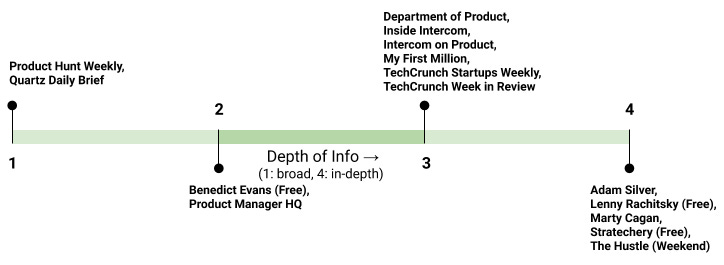
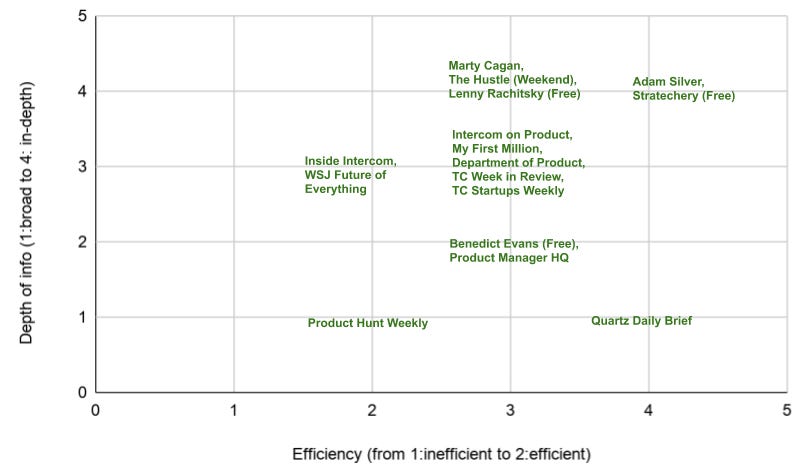
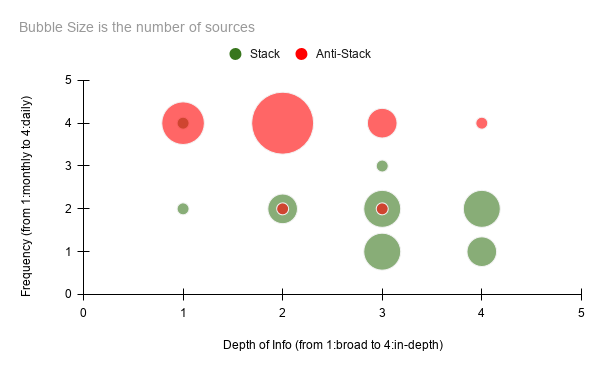
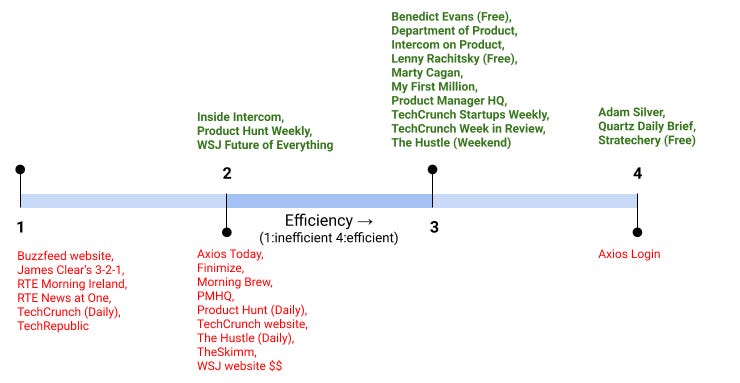
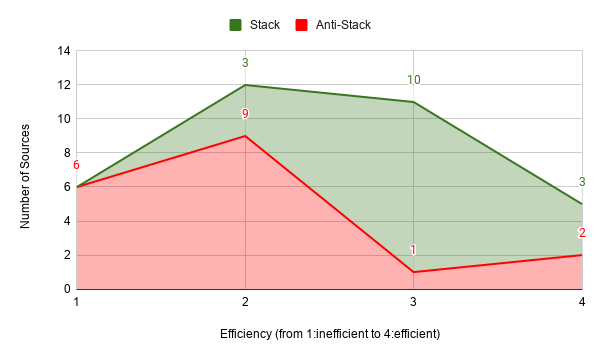
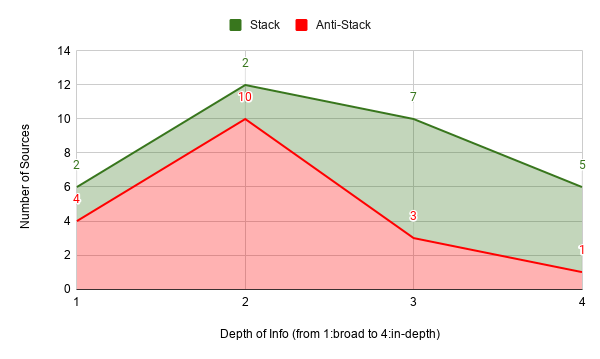
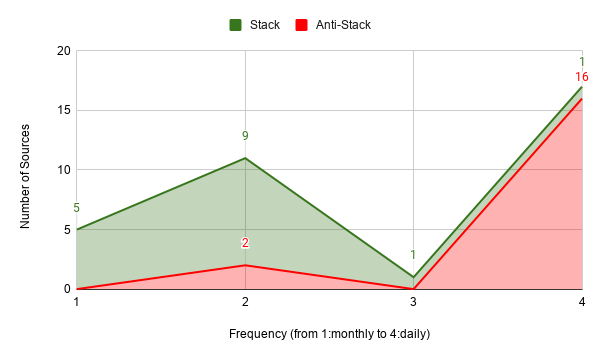
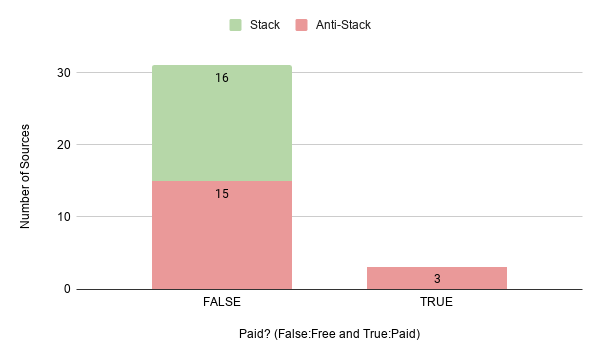
Enjoyed reading your analysis leading to your curated list. Nice work, Harshal!
Thanks for the information! Well written and strongly justified. I've subscribed to most of the product newsletters and podcasts listed here